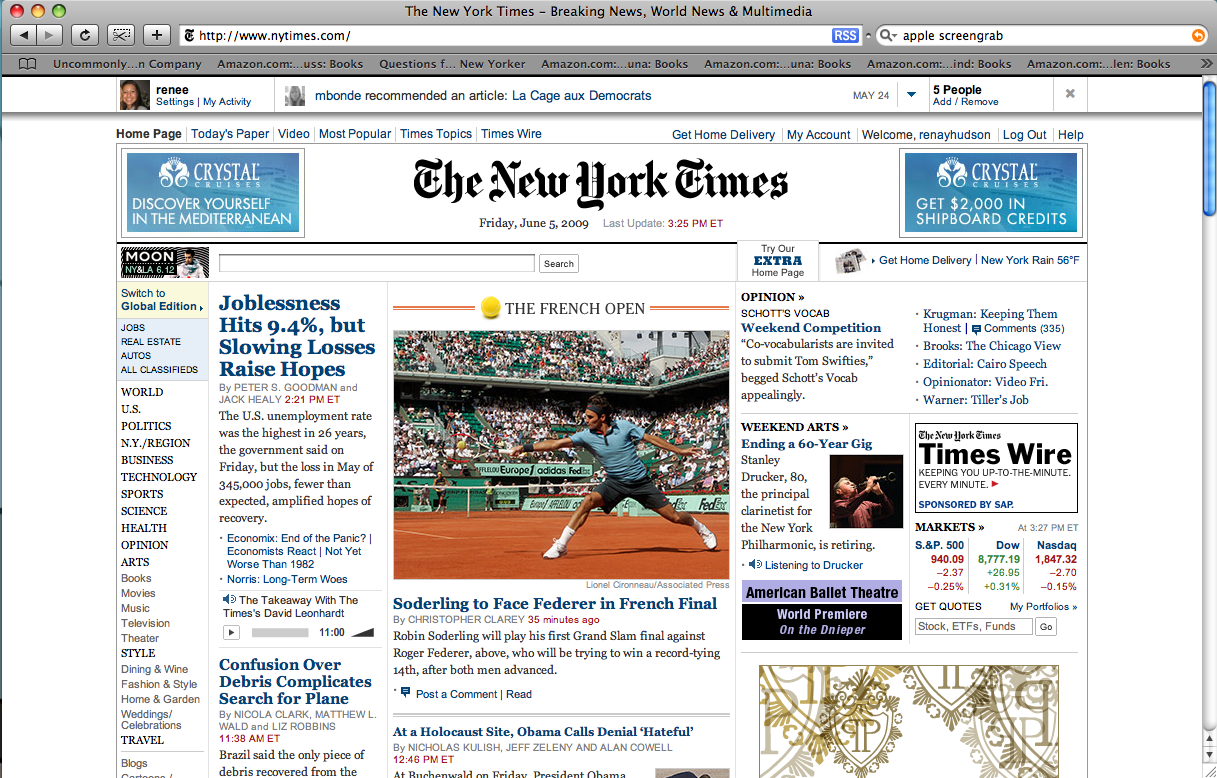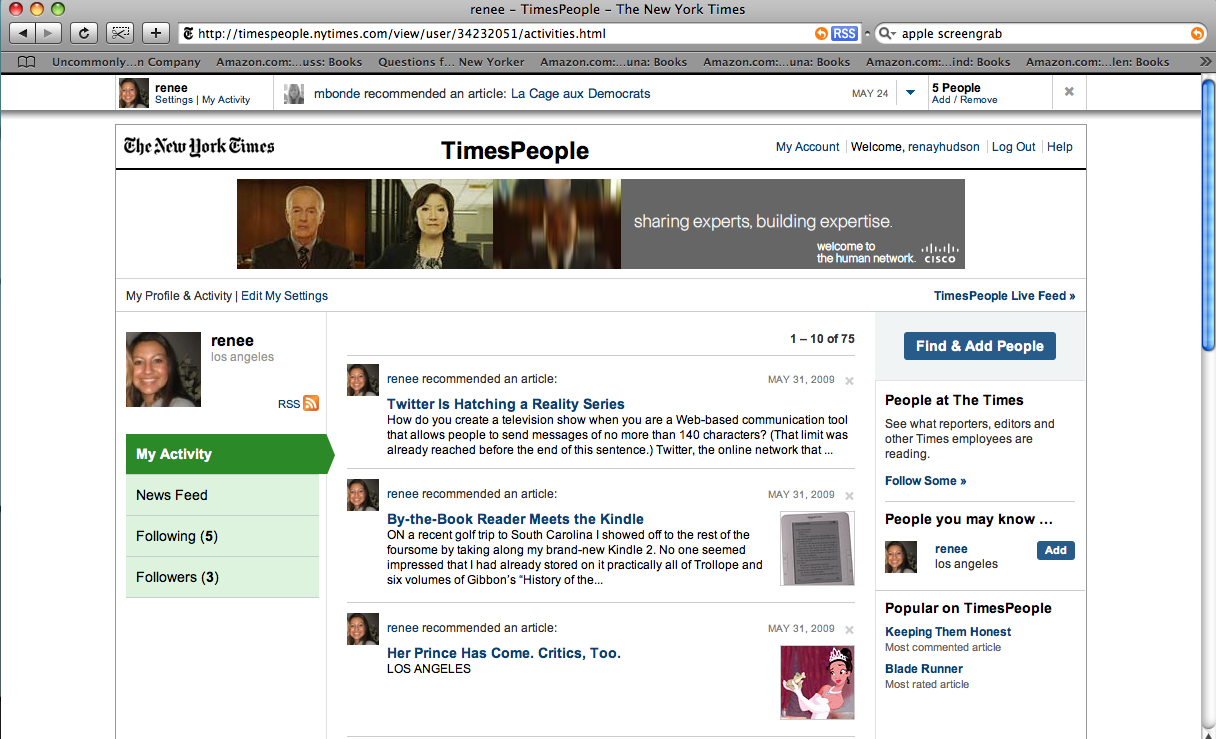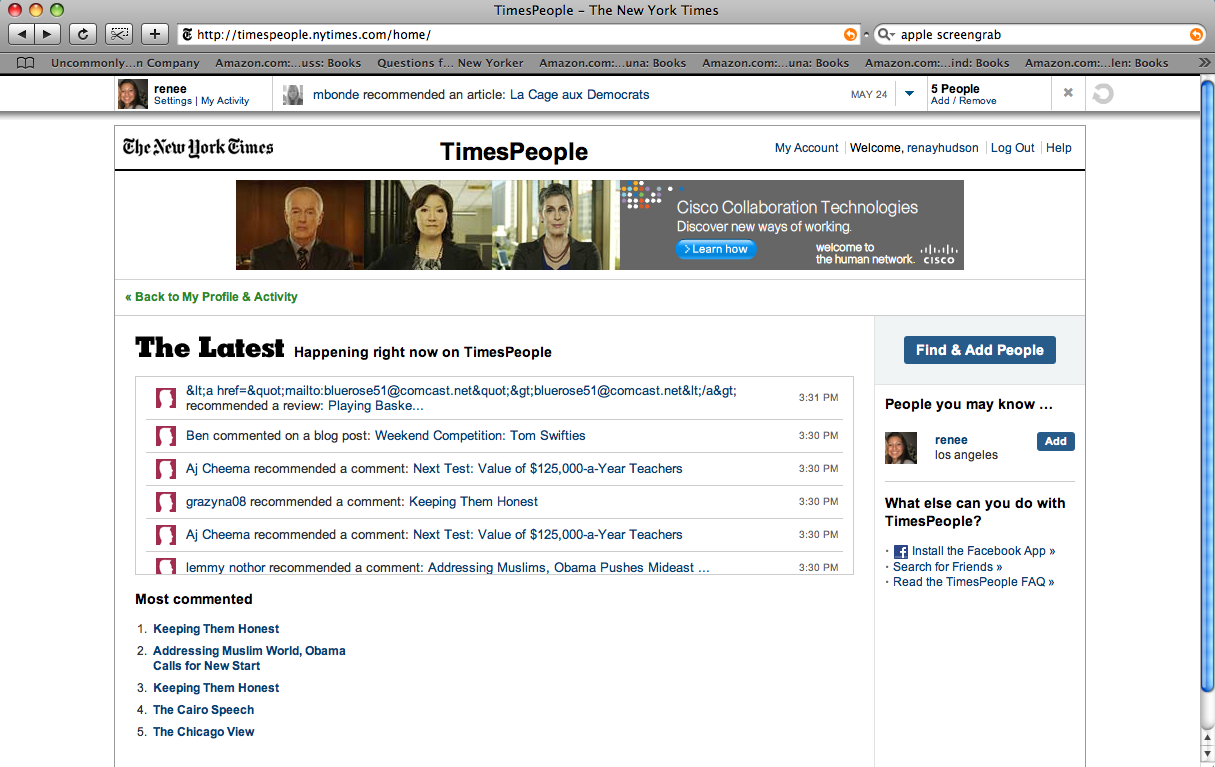(created 6/07/09; version 1.0)
Related Categories: Social Networking Systems | Collective Reading
Summary:The New York Times released TimesPeople on June 18, 2008 with the goal of creating a social network based on sharing content from the website. The June 18th launch, previously available only in Firefox and as a plug-in, became more widely available in September 2008 and allowed users additional features like the ability to sync their TimesPeople activity with their Facebook accounts. More recently, in February, The New York Times added the TimesPeople API to their current list of APIs to facilitate interaction with the Times outside of the website and to move one step closer to reimagining the future of the news through collaboration with developers.
While TimesPeople markets itself as a social network, its stripped down style can be likened to something more along the lines of a tool than a network. Like Twitter, rather than having “friends” on the site, users follow other users and are followed in turn. Profiles are limited to handle, location, and image. Rather than creating content like a blog post or a Facebook note, users interact with the NYTimes.com website through their actions with Times created content. This content ranges from slideshows and articles users share with others to comments, reviews and ratings of movies and restaurants.
Once a user signs up for TimesPeople (any registered user of the website may do so), they can access information from the toolbar at the top of the page (which shows the latest updates from the users one follows) or by looking at a user’s page, which lists all TimesPeople activity. The toolbar, in addition to allowing a user to access his or her own settings, activities, and profile easily, lists the most current update (only one at a time) with the handle of the user that performed the action (recommending, commenting, etc.), the relevant article, and the date. By pressing the down arrow, a user can scroll through other updates, and view the dates for each. Users can easily add or remove people they follow with a link next to the arrow and, if a user so chooses, can close the toolbar itself by clicking the “X” to the right of the bar.Clicking on one’s own username or “My Activity” allows a user to view his or her page. The page features a sidebar that allows a user to view “My Activity,” “News Feed,” “Following,” and “Followers.” The first section, “My Activity” lists all the user’s activity on TimesPeople, from recommendations to comments. “News Feed” provides a list of all updates from people a user follows while “Following” and “Followers” list the people in each category.
Additionally, a user may follow the “TimesPeople Live Feed” on any page to see a list of updates by other users. There is also a space on the right-hand side of the page that lists what is most popular on TimesPeople based on comments and ratings.
Users can also sync their TimesPeople activity with their Facebook account so that Facebook friends can receive updates. Facebook users can choose to have a TimesPeople tab and / or box added to their profile and whether or not to publish TimesPeople updates to their Facebook news feed. While the TimesPeople tab lists all update activity, stories posted to the news feed allow Facebook users the opportunity to comment on an update as well as click on whether they like the posted update. Twitter users can also follow TimesPeople to view updates on which pieces of content are most commented on, recommended, and rated.The TimesPeople API allows developers the opportunity to rethink how users interact with TimesPeople. For instance, a developer created a Google gadget using the TimesPeople API that allows users to access their TimesPeople news feed from their Gmail account.
Research Context:
TimesPeople is an important stepping stone as newspapers transition from functioning in a print culture to a digital culture. By emphasizing the need to implement a social element to the newspaper, TimesPeople fundamentally reveals how digital culture has changed not only reading practices, but also how those practices are crucial to the ways in which people interact with one another. Rather than simply reading a news article, users are expected to recommend, rate, comment, and – most importantly – share these actions with others. With the proliferation of news outlets, news sources have become increasingly specialized and tools like TimesPeople help readers locate the kinds of information they seek by following the activities of other users. In doing so, users can access information from other users with similar tastes or gain access to new threads of information from users with different interests. Because tools like TimesPeople highlight the role of sharing information, reading as a social practice emerges as one of the fundamental attributes that underpins how we read in a digital culture.
Technical Analysis:
TimesPeople supports most browsers, though Javascript and cookies must be enabled in order to function properly. The tool also supports the Mac OS X, Windows XP and Vista operating systems.
Evaluation of Opportunities/Limitations for the Transliteracies Topic:
TimesPeople, as a social networking tool based on reading the news, emphasizes how online reading interfaces are increasingly inseparable from social computing. In fact, part of the thinking that went into the creation of TimesPeople stemmed from the realization that in order to keep The New York Times viable in a digital culture, the Times would have to do more than simply make their content available online. The developer section of the website (http://developer.nytimes.com/docs), in addressing the need for Times APIs, explicitly hopes that in seeing what developer’s do with the APIs, the Times can see what direction the newspaper should take in the future.
In locating the future of the newspaper (and not just the Times) within the realm of social computing, TimesPeople acknowledges how reading practices have changed from solitary activities to communal practices. Moreover, by making user actions public (comments, etc.), TimesPeople also highlights how a reader’s relationship to texts has changed. Aside from commenting and recommending, these actions occur in public spaces beyond the Times website in places like Facebook and Twitter, thus underscoring the fact that actively engaging with texts carries the conversations about them outside the sphere of the newspaper. The ability to create new applications using the API further stresses this point since the goal of creating an API is to allow other developers the chance to create reading opportunities on sites all over the internet.
TimesPeople is therefore an important object of study for the Transliterates project because it simultaneously points to how we once read newspapers, how we read them now, and what the future of reading might look like. TimesPeople is an important case study because, while it focuses on the Times, it also has broader implications for newspapers in general as well as other texts. An interesting experiment with TimesPeople would be to compare it to how other newspapers create online communities and analyze what aspects of each approach are successful. Thus far, one of the main limitations of TimesPeople is that, while it incorporates ideas from other existing tools like Twitter and Digg, it still needs to think through what is unique to the Times and how this distinction can be leveraged to think outside already existing tools to create a fresh approach to reading the newspaper. Indeed, one of the strengths of the Times is the fact that, aside from being one of the most respected names in the industry, it creates the majority of its own content. Were the Times to utilize its cultural capital, an interesting route to take would be to form partnerships with other major newspapers to create a universal tool for the newspapers’ readerships such that more traffic will be driven to each newspaper and will not suffer from the limitations imposed by focusing on only one paper, as is the case with TimesPeople.
Resources for Further Study:




